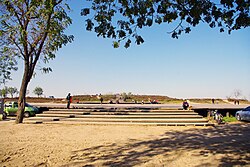You can help expand this article with text translated from the corresponding article in Chinese. (December 2008) Click [show] for important translation instructions.
|
Weiyang
未央区 | |||||||||||||||||||||||||||||||||||
|---|---|---|---|---|---|---|---|---|---|---|---|---|---|---|---|---|---|---|---|---|---|---|---|---|---|---|---|---|---|---|---|---|---|---|---|
 Ruins of Weiyang Palace | |||||||||||||||||||||||||||||||||||
 | |||||||||||||||||||||||||||||||||||
| Country | People's Republic of China | ||||||||||||||||||||||||||||||||||
| Province | Shaanxi | ||||||||||||||||||||||||||||||||||
| Sub-provincial city | Xi'an | ||||||||||||||||||||||||||||||||||
| Area | |||||||||||||||||||||||||||||||||||
• Total | 264.41 km2 (102.09 sq mi) | ||||||||||||||||||||||||||||||||||
| Population (2020) | |||||||||||||||||||||||||||||||||||
• Total | 733,403 | ||||||||||||||||||||||||||||||||||
| • Density | 2,800/km2 (7,200/sq mi) | ||||||||||||||||||||||||||||||||||
| Time zone | UTC+8 (China Standard) | ||||||||||||||||||||||||||||||||||
| Postal code | 710016 | ||||||||||||||||||||||||||||||||||
| Xi'an district map |
| ||||||||||||||||||||||||||||||||||
Weiyang District (simplified Chinese: 未央区; traditional Chinese: 未央區; pinyin: Wèiyāng Qū) is one of 11 urban districts of the prefecture-level city of Xi'an, the capital of Shaanxi Province, Northwest China. It is located at northwest Xi'an, functioning as the new administrative centre of the city. The district borders Baqiao District to the east, the city of Xianyang to the west, Xincheng District and Lianhu District to the north, as well as Yanta District and Changan District to the southwest. The geographical coordinates are 34°14'50''N ~ 34°26'22''N, 108°47'08''E ~ 109°02'21''E, and the total area is 264.41 square kilometers.[1] By November 11, 2020, the total population of permanent residents in the district is 733,403, taking up around 5.66% of the city's population.[2]
Weiyang District had significant historical importance. It is named after the ruins of Weiyang Palace of the Han dynasty which is located inside the district, meaning "the prosperity never ends" (繁荣兴盛,不尽不衰).[1] It is also the origin of the Silk Road.[3] 11 ancient dynasties built their capitals inside the modern time Weiyang District, including Qin, Western Han, Eastern Han, Western Wei, Northern Zhou, etc.[4] Among the many historical relics located in this district, Site of Epang Palace, Site of Daming Palace, and Han Chang'an City Site were listed in the first batch of Chinese national key cultural relics protection sites in 1961 by the State Council of the People's Republic of China.[5]
- ^ a b "行政区划-西安市未央区人民政府". www.weiyang.gov.cn. Retrieved 2022-01-22.
- ^ "西安市第七次全国人口普查主要数据公报[1](第二号)-西安市统计局". tjj.xa.gov.cn. Retrieved 2022-01-22.
- ^ "未央宫遗址:汉文化发源地 丝绸之路起点--财经--人民网". finance.people.com.cn. Retrieved 2022-01-22.
- ^ "历史沿革-西安市未央区人民政府". www.weiyang.gov.cn. Retrieved 2022-01-22.
- ^ "国务院关于公布第一批全国重点文物保护单位名单的通知_中国概况_中国政府网". www.gov.cn. Retrieved 2022-01-22.
